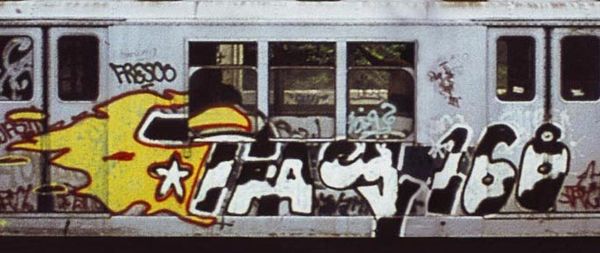
Dimensions: image/sheet: 12.7 × 73.66 cm (5 × 29 in.) mount: 24 × 86.36 cm (9 7/16 × 34 in.)
Copyright: National Gallery of Art: CC0 1.0
Curator: Henry Chalfant’s photograph, “Bil Revolt,” taken in 1980, showcases an entire New York City subway car engulfed in graffiti art. Its dynamism practically leaps out at you. Editor: It does! What immediately strikes me is how this photo documents labor. So much surface, meticulously layered with acrylic paint. Think about the clandestine hours and collaborative energy! Curator: Absolutely. Notice the rhythm created through the repeated rectangular shapes of the windows above. The graffiti then bursts forth— an organized chaos with its interplay of geometric and organic forms. Consider how those hard edges play against the wild, blossoming explosions of color. Editor: And each color seems to be shouting its own message, a rainbow coalition of resistance against the drab uniformity that public transit often embodies. You get a strong sense of the sheer volume of aerosol cans emptied to create this rolling canvas. I wonder where all these cans end up after... Curator: Material waste is a fair concern, but I find myself focusing on how Chalfant’s documentation freezes this transient act. We often discuss the ephemeral nature of graffiti, yet here it gains a certain permanence. A semiotic rebellion, if you will. The style of lettering becomes its own complex visual language. Editor: And look closely—figurative elements emerge too! Little cartoon characters nestled within the tags, evidence of individual artistic expression amid a collective visual movement. It really challenges traditional art hierarchies. Is this vandalism, or a people's art gallery careening through the city's underbelly? Curator: The line blurs. Chalfant offers us a perspective where we must question established notions of property, authorship and aesthetics. There is a vital aesthetic argument in what we might otherwise just label "urban decay". Editor: I think the inherent "illegality" adds to its allure too, subverting societal expectations and claiming public space, literally transforming what can be a soulless metal box into something visually and conceptually exciting. An almost utopian visual field moving against the dominant culture. Curator: Yes, a visual scream given voice. So what we are really seeing here isn't only an artistic work, but also documentation of a social intervention. It brings a poignant, thoughtful end to this overview. Editor: Absolutely, seeing it as documentation as a specific cultural moment makes me respect its lasting importance so much more.
Comments
No comments
Be the first to comment and join the conversation on the ultimate creative platform.













